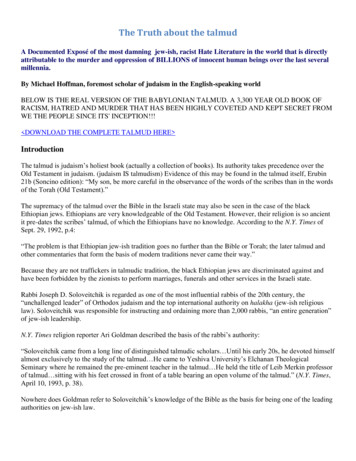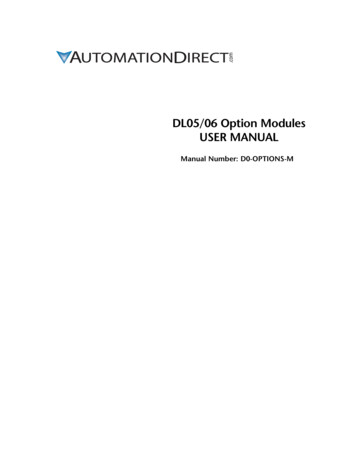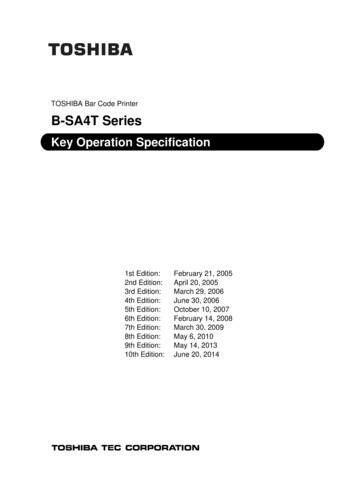
Transcription
''ill:".;PiH:111i
BM 500 .R6 1896 v. 19-20Talmud.New edition of theBabylonian Talmud-2,0
vT alh iuclEl.THEHISTORY OF THE TALMUDfrom tbc XTime of 1Fts formation, about200 B. G., up to tbe preseut XTimeDIVIDED INTOVOLUMEI.— ITSTWO VOLUMESDEVELOPMENT AND THE PERSECUTIONS SINCEITSBIRTH UP TO DATE, INCLUDING ALL RELIGIOUS DISPUTESAND BRIEF BIOGRAPHIES OF THE SEPARATED SECTSVOLUMEII.— THENEWHISTORICAL AND LITERARY INTRODUCTION TO THEWITH ILLUSTRATIONSEDITION: ETHICS, METHOD,CRITICISM, ETC.BYMICHAELL.VolumeNEW TALMUD1117RODKINSONI.(XIX.)NEW YORKPUBLISHING COMPANYSimpson Street
Copyright,MICHAELL.1903,byRODKINSON
THE REV. MICHAELL.RODKINSON,D. T.
TO HIMWHOISA LIBERALDONOR TO ALL PHILANTHROPIC INSTITUTIONSA FRIEND OF ISRAEL'S PUREST IDEALS, LITERATUREAND RELIGIONADOLPH LEWISOHN,THIS BOOKISMOST RESPECTFULLY DEDICATED BY THE AUTHORMICHAELNewYork,inEsq.MonthL.Elul, SeptemberRODKINSONist, 1903
—PREFACE.Theancient authors used to begin the prefaces to theirworks with the proverb "Sepher be Lo Hakdamha keguph beLo nechamaha," which means "A book without a preface issimilar to a body without a soul" and, indeed, this proverbremains forever true. At the time we began our translationof the Talmud, we were aware that to the study of it a clearpreface which should explain its nature and the character ofthe sages mentioned in it was necessary, as without it therewould be great difficulty for students in catching the realmeaning, and in some places the reader would be confused,not being aware of its history and of the names mentioned;who these were and when they existed.With this in mind, we had already prepared the presentwork in 1897, when only a few volumes of our translation hadbeen issued. Although we gave a brief general introductionfirst volume of the translation, and also some prefacesand introductions in the succeeding volumes, they do not suffice for the student who desires to have a clear idea of all thatto theheisstudying.However, the translation has taken up so much of our timethat it has hitherto been impossible for us to look up everything pertinent to our purpose that has been written and tosubmit it in presentable form. Now, after the completion,with the Divine help of the two large sections, containingtwenty-seven tracts, and in response to many inquiries from thereading public for some explanations, we find that now is thetime to put forth this work; and, instead of adding two morevolumes to the translation of the Talmud in the current year,we have decided to furnish the two volumes which form our"History of the Talmud."It may be inferred that what was written several years agohas had to be thoroughly revised and corrected, according tothe literature which has appeared since that time.Thereisan
PREFACE.viold witticism,"Koshe Atika Me Chadtha"; i.e., "It is morean old thing than to write a new one " and.difficult to correctas a matter of fact,;ithas taken a great deal of time tomakethe necessary changes and corrections in what we had written.As a natural consequence, the work is enlarged, and manychapters have been added since the issue of our prospectus.All this concerns the first volume of this work, as it relates tothe history of the Talmud only, as to which there has beenlittle new information.True there have been some new dissertations on the Talmud in Germany, but they do not addmuch to our knowledge concerning it, and may therefore beignored.The second volume, however, we have had to recast andIn this labor the wonderful work of that westernlight which was recently extinguishedwe mean the Rev. Dr.rewrite.Mielziner—— "Introduction to the Talmud,"which has reacheda second edition and has been so favorably received by all students of both continents, was of great service to us. As Dr.Mielziner's work contains essentially all that concerns the Talmud itself, we resolved to take it as a text for our historicalintroduction, addingand abating as we deemed necessary.We have done so, also, with the second part,"The Ethics of theTalmud," which he arranged so admirably. Here, also, wehave added whatever, according to our knowledge, there wasleft forus to bring to the attention of the reader.Now, the work beingfinished, we regard it as a suitablepreface to our translation and one which will enlighten theunderstanding of the reader in many places. At the same time,it seems to us to be interesting to the general reader who hasneither time nor inclination for the study of the Talmud.ThisformoreNewis allwe need sayin the preface, referring the readerdetails to our introduction,whichfollows.The Author.York, September,1903.
CONTENTS OF VOLUMEI.PAGEPrefaceIntroductionviCHAPTERI.The Origin of the Name "Talmud." The Samaritans.Antiochus Epiphanes. The Sadducees.CHAPTER5II.The Development of the Talmud During the Last Century of the Second Temple's Existence (i.e. TheAbtalian.First A.C.)Shemaia.The Princes(Nasis) of Israel.Sanhedrin of Jamnia.Shammai.Zakkai.The Jewish ChristiansR.b.CHAPTERThe DestructionThe MassacreHillel.Johanan.7III.The Fall of Bethel.of the Sages of the Talmud, Till theWriting of the Mishna in the Beginning of theof the Temple.Third Century10CHAPTERIV.The Third Century. The Arrangement of the Mishnas.The Talmudic Colleges of Palestine and Babylonia.CHAPTER13V.The Talmud of Jerusalem, the Talmud of Babylonia,the Character of Their Halakha and Hagada, theDates of Their Completion and Their SystemaTxZation17CHAPTERThe PersecutionsTalmudVI.the Persian and Byzantine Empires in the Sixth Century After theClose of the Talmudof thein23
CONTENTS.viiiCHAPTERVII.PAGEThe Eighth Century. The Dominion of the Gaonim. TheOpposition of the Karaites. The Establishment ofa Sect of That NameCHAPTERIslam and Its Influence on theVIII.TalmudCHAPTER25. .33IX.The Victory of Karaism Over the Spiritual Dominion ofthe Talmud and the Mind of the Jewish Nation.The Last Gaonim at Sura and Pumbeditha. TheCentre of Talmudic Study Transferred from Mesopotamia to Spain. The Scholars of Kairuban. ThePeriod of the Greatest Diffusion of TalmudicStudy36CHAPTERThe Spanish Writers.AX.Brief Survey of Their WritingsRelating to the TalmudCHAPTER43XI.The Scholars of Germany and of Northern France, andWhat They Contributed to the Studies of the TalmudCHAPTERThe Doctors of France.XII.Authors of the TosphothCHAPTER.57XIII.Religious Disputes of All PeriodsCHAPTER5061XIV.Reuchlin, Pfefferkorn, and the Talmud in the Sixteenth and Seventeenth Centuries.76Polemics with Mussulmans and the Disputes with theFrankists99CHAPTERXV.
CONTENTS.CHAPTERixXVI.PAGEThe Persecutions of the Seventeenth Century, the Headof Whom was Johann Andreas Eisenmenger.CHAPTERCHAPTERinthe106XVIII.of Rholing-BlockCHAPTER109XIX.Exilarchs; the Talmud at the Stake and Its Development at the Present TimeAPPENDIXNos.1104XVII.The Polemics and the Attacks Upon the TalmudNineteenth CenturyThe Affair.115A.to 18 Contains Eighteen Explanatory Notes tothe Text121No. 19 Contains an Extract of the Conclusion ofReview to Dr. Kopf's Book, Mentioned in TextNo. 20 Contains a Translation of a Few Pages of.Our.125OurBook, " Der Schulchan Aruch und seine Beziehungenzu den juden und nlchtjuden," concerning theTrial Before the " Landesgerichte," at Munster,Dec. 10, 1883, About the Accusation of the Talmudand Schulchan Aruch.No. 21 Letter of the Theological SeminaryNo. 22 Jewish EncyclopaediaAPPENDIX.126136136B.Chapter VII. (Karaites). The Beliefs ofSadducees, Karaites, and of the Reformed Jews, andalso About ResurrectionCriticism to138
INTRODUCTION.The persecutorsfrom thefirstof thecenturyB.C.,Talmud during the period rangingwhen it began to take form, to thepresent day, have varied in their character, objects and actions.In one respect, however, they all agreed, namely, in their generalwish to destroy its existence. Careful consideration of its manyvicissitudes certainly justifies the assertion that the Talmud isone of the wonders of the world.During the twenty centuriesgreat andpowerful enemies vying with each other and exhausting everyeffort to destroy it still it survived in its entirety, and not onlyhas the power of its foes failed to destroy even a single line,but it has not even been able materially to weaken its influence for any length of time. It still dominates the minds of awhole people, who venerate its contents as divine truth, andcountless numbers have sacrificed their lives and their possessions to save it from perishing.of its existence not one ofthem has passed without;Areview ofitspersecutors, before going into their historyThey are the Seleucidae, in the time ofAntiochus Epiphanes, the Roman Emperor Nero, Domitian,Hadrian, etc., the Samaritans, the Sadducees, Boethuseans, thefollowers of Jesus, and all the sects opposed to the Pharisees.Before the development of the Talmud had been completed,when hardly a single section had been arranged systematicallyand written down, it having been known merely as oral teaching in the mouths of the sages, and reconsidered and analyzedwould not be amiss.constantly by their disciples in the colleges,it was violently atBut no sooner had the Talmud been completed in Babylonia, and the Saburites had put their seal upon it, so to speak,deciding that nothing was to be added to or substracted from,tacked.when Justinian decreed practically its death that is to say,what amounted to the same thing, capital punishment to allthose who were occupied in its study (550). Then followed theKaraites, in the days of the Gaonim, who seriously threatened;
INTRODUCTION.2Time and time again they triumphed over Talmudic Rabbis and were near making an end of the Talmud andThe Rabbis next encountered the Popes. From theof them.time of Pope Innocent III., the Talmud was burned at thestake in nearly every century from the i ith to thei 8th, in Italy,France, Germany, Spain, and many other countries, and in the1 8th, also in Poland by the Frankists, by Bishop Dembovski,where copies were dragged through the streets of the city, tiedto horses' tails and then delivered to the executioner to beburned at the stake in Kamenetz, Lemberg, Brody and elsewhere. In most places, before it was resolved what was to bedone with Talmud, the Israelites were forced to dispute withits enemies, and had to pay heavy fines for arriving late to theits existence.dispute, as well as for being vanquished in argument, the judgesbeing their enemies.Stillthe persecutions againstand calumnies bySemites, arestillitsitThewhat has been the result ?mud exists to-day, and not one letter in it is missing.are not yet at an endenemies, under thedirected againstit,;Tal-It is true,accusationsnew nameof anti-while the government ofRussia legislates against and restricts the rights of the nationwhich adheres to the Talmud. No modern persecutions, however, can seriously endanger its existence, and it would appearthat the Talmud will also survive them and continue as long asthe sky spans the earth.A desire to know all that has befallen the Talmud and all itsvicissitudes since its inception would require the reading of allthe scattered passages in countless volumes which have beencompiled in various ages, languages, and countries. Its history, however, has never yet been written by a single author.Treaties on the Talmud itself, or on certain subjects containedtherein, have briefly related part of its history, each accordingto the subject and the aim of its theme.Such are the works ofZunz and Gratz, the one dealing with rabbinical literature, andthe other writing concerning the history of the Jews. Similarlythe historians of the world, relating in detail the occurrences ofevery century, have briefly made mention of what happened tothe Talmud in each century. Even in the year there appeareda pamphlet entitled "Anklager und Vertheidiger des Tal-mud"(accusersand defenders), by Dr.B.Kurrein,ofFrankfort-on-the-Main, apparently giving the entire history of
INTRODUCTION.3the Talmud from its origin to the present time, but it containsonly dates (and not even these in full) and not occurrences. Nomention is made of Karaites, who persecuted it in the times ofthe Gaonim, or of the Frankists of the 18th century, of its fateduring the 15 th century; the Pfefferkorn and Reuchlin episodementioned only in part, and by no means satisfactory to thereader curious about the details, not to speak of the RohlingBloch, at the end of the 19th century. It is, indeed, a matter ofastonishment that hundreds of books have been written aboutisthe Talmud by exponents of all sects and in all ages, to saynothing of the extensive modern literature dealing with theTalmudinwhole or in part, amounting to thousands of volumes" Dikduke Sophrim," published inthe—in particular a work,last century, containingonly the dates and publishers namesTalmud, in seventeen large vol'of the various editions of theumes, with a comparison ofall words and letters of the differentand manuscripts, and this only of two-thirds of theTalmud the fate of the Talmud, the charges brought againstit, the repeated persecutions, the burning at the stake, havenot been recorded in a separate work, as though unworthy ofeditions—It has been thus left for us to supply the deficiency.For we, who have taken upon ourselves the difficult task ofediting the old Talmud, to punctuate it in conformity withworks in other languages, to systematize and arrange it for anew edition, and to translate it into a modern language, deemit our duty to collect into one book all the records of the vicissitudes of the Talmud in a systematic manner, at the same timenotice.stating the causes ofmany occurrences.many places we have been constrainedIt is quite true, that inmore ample account would not have been outmust be borne in mind that to expatiate onevery incident would lead to the writing of a volume equal inbulk to the Talmud itself, perhaps even larger, and time wouldto be brief where aof place,butitnot permit such an undertaking. In one respect, however, wewill do our duty we will arrange all the events chronologically,;and we have taken pains to denote the time and place of different events and likewise to name the persecutors of the Talmud.We trust this volume will meet with a favorable reception fromthe readers, for our work was done conscientiously, and to theutmost of our talents. To save space, we have not on every
INTRODUCTION.4occasion mentioned the authorities fromwhom wederived ourbut only when we had to refer the reader for details toother books we gave the name and page of the book. We maystate, however, that the sources on which we have drawn are allthe books which speak of this subject, viz. the Talmud itself,the books of the Gaonim, and those written on this topic in thefacts,:Middle Ages, as well as the extensive literature relating tothe last century, from Zunz, Jost, Herzfeld, Graetz,etc.,itofto thepamphlet we have mentioned.At the conclusion of the bookmethod employed inthe new edition and translation of the Talmud, and at the sametime a full introduction. We made it as lucid as possible, andalso endeavored to reply to some criticisms that have appearedin various periodicals since the new publication had firstthe reader will find an explanation of theappeared.MichaelNewYork, August,1903.L.Rodkinson.
THE HISTORY OF THE TALMUD.CHAPTERI.—THE ORIGIN OF THE NAME " TALMUD " THE SAMARITANSANTIOCHUS EPIPHANES THE SADDUCEES.The name "written law" was given to the Pentateuch,Prophets and Hagiographa, and that of "oral law" to all theteachings of the " sages " consisting ofcomments on the text ofThe word Torah alone was applied to the entireBible, the term "Talmud" was reserved for the oral law,though the meaning of these two words is identical; namely,the Bible."teaching" or "study. "Still,becauseit iswritten Velimdo(Deut. xxxi, 19), and teach it the children of Israel (put it intheir mouths that is to say that the teacher's duty was to ex;and comment on the laws and ordinances until the children understood them thoroughly and were conversant withthem by heart) the name "Talmud " was applied to what wasplain—styledby a long phrase" OralLaw "(Torah-she b'al-Peh) This.word designated all the commentaries of the sages on the Scriptures which the Pharisees had begun to interpret figuratively.Figurative interpretation was inaugurated in the days of theGreat Assembly when its members resolved to keep themselvesdistinct from the Samaritans, their inveterate enemies, who adhered to theliteral interpretation ofopinion of the Pharisees, was falsifiedhowever, commenced tomakethe text, which, in theby them.This study,progress at the time of the San-Macedonian conquest of Judea, whenthe term " Great Assembly " was changed to the Greek " Sanhedrim'It spread into every college where were assembled sageshedrin, or from that of the'entrusted with the guidance of congregations, with instructionof the Law, of ordinances relating to clean and unclean, to prop-
THE HISTORY OF THE TALMUD.6erty, to crimes.All sageswhointerpreted the biblical passagesfiguratively, unlike the Samaritans,were called "Pharisees."The Samaritans of course persecuted those Pharisees (see App.No. i), objected to their interpretation, and did them great injury whenever they had the power. At last, Janai, Hyrcanusthe First, overcame them, burned their temple, devastatedand compelled them by force of arms to conductthemselves according to the doctrines of the Pharisees, thoughhe himself in his latter years became a Sadducee.their city,Until the time of Antiochus Epiphanes, before which periodallthe high priests since the erection of the second templehadbeen of the family of Zadok, King David's high priest (see App.2), and the priests had been also among the sages of the Pharisees and no disputes arose between them as to the interpretation of the law.From the time of Antiochus, however, whenthe high priesthood passed from the descendants of Zadok toother families, finally coming into the possession of the Maccabees, who were not descendants of the house of Zadok, began todiffer from the Pharisees in the interpretation of the Torah, andto explain the texts on the basis of oral tradition.Theyfounded a distinct sect, styled " Sadducees" (after Zadok), andthe dispute with the Pharisees and their teaching, i.e. with theTalmud, was begun. They persecuted the Pharisees to theutmost being mostly men of wealth and rank, and in theirhearts leaning toward the Hellenes, who then held sway in Palestine, they joined the Samaritans, the foes of the Jews, whoseaim was to eradicate the study of Judaism. Thus united, theygave their aid to Antiochus Epiphanes, who was anyhow theenemy of the Jews, and who decreed on the pain of capital punishment that the Pharisees should discontinue their studies,that circumcision should be performed in a manner other thanthat prescribed by the Pharisees (see App. No. 3) that the Sabbath should not be observed according to the interpretation ofthe Sabbath law by the Pharisees, etc. The obvious intentionwas to destroy the Talmud together with Pharisees who adheredThese persecutions against the Talmud ended usually into it.favor of the Sadducees until the time of Simon ben Shetah, andthe above mentioned Janai, Hyrcanus I. (Johanan the HighThen the Pharisees triumphed over their foes, and thePriest)oral law was the absorbing subject of the Sanhedrin, under the;;.
THE FIRSTA. C.7Simon b. Shetah and JehudahThe Talmud was then studied in all colleges of Palestine, Egypt and wherever Jews lived. Owing to the enmityof the Samaritans and the opposition of the Sadducees, manylaws and regulations were added to the Talmud of the Pharisees.leadership of Joshuahb. Prachia,b. Tabai.Fromthat time the Pharisees began to restrict their interpreta-tions so as tomake themmeaning of thetexts,agree with the deep though literalemploying therein much sophistry. Theycounted all the letters of the Torah, and if they found a word orletter not absolutely necessary to the understanding of thetext, they said it was placed there only to add to or subtractfrom the meaning. But at that period the Mishna was not aseparate and distinct thing from the Talmud, though manyancient Mishnas already existed in writing, but without a sepaThe Pharisees studied the ancient Mishnayoth,rate title.added (see App. No. 4) to them, and explained the biblical texts.All this was entitled Oral Law, or, shortly, "Talmud."CHAPTERII.THE DEVELOPMENT OF THE TALMUD DURING THE LAST CENTURYOF THE SECOND TEMPLE'S EXISTENCE {i.e. THE FIRST A.C.)SHEMAIA ABTALIAN HILLEL SHAMMAI THE PRINCES(NASIS) OF ISRAELR. JOHANAN B. ZAKKAISANHEDRINOF JAMNIA THE JEWISH CHRISTIANS.————After the triumph of Simon b. Shetah over the Sadducees,when he had finally cleared the Sanhedrin of them, and only thePharisees remained there, the development of the Talmud progressed rapidly, for the number of the sages, the adherents,Talmud, increased greatly in the colAshkaloth (Duumviri) who succeeded to ben Shetah Shemaia and Abtalian, and, after them, Hillel and Shammai. And although at that time new enemies arose, in theBoethuseans, Essenes, and many other sects who were opposedto its particular doctrines, yet those had not the power to checkits progress or to weaken its influence— not only on all Israelites,wherever they dwelt, but also on many Gentiles for at thattime we see that prominent persons of other nations (App. No.5) come to the chief men of Israel and express their wish toreverers, sanctiflers of theleges of the::
8THE HISTORY OF THE TALMUD.adopt Judaism. Hillel the Elder received them with openarms. Helen the Queen, and her son, Isotis, also accepted thecreed of the Talmud. All this was due to the fact that itsmorality came at this time to be before the world. The Polytheists began to perceive the great difference between the teaching of their priests in the names of the gods, and the Torah asexplained by its sages. From all places of the world came persons to learn the doctrines and the morality of the Talmud.This period of good fortune, however, was only of short duration, as the time of the destruction of the Temple was nigh, andwith it the victims of the sword and of hunger were many.Among these were the great sages who bore the banner of theTalmud, and their wisdom died with them. The Sanhedrinhad been forced, while the Temple was still in existence, totransfer their meeting places from the "marble hall" to the"shops."Rabban Gamaliel the Elder, the son of Hillel thePrince (Nasi) was persecuted by them, and his son Simeonwas slain, together with many sages. Thus, if R. Johananb. Zakkai had not, risking his life, petitioned Vespasian tospare the Sanhedrin, who had been compelled during thetumults at Jerusalem to move with their college to Jamnia,there would have remained no vestige of the Talmud, since mostof those who cherished it had passed away by the sword, byhunger and by the plague. Besides, the disciples of Jesus (seeApp. No. 6), who then believed in his Messiahship, but not in hisdivinity, began secretly to undermine the Talmud, which laidmore stress on external ceremonies than they deemed necessary,and endeavored with all their might to weaken its influenceamong the populace, but R. Jehanan b. Zakkai and the Sanhedrin in Jamnia, with Rabban Gamaliel, the son of the slainSimeon, at their head, restored the Talmud to its prestige,and took pains to raise up others in the places of the murdered sages.Thus the studyof theTalmudflourished after the destruc-tion of the Temple, although beset with great difficultiesandJohanan b. Zakkai wasobliged to dispute with Sadducees and Bathueians and, nodoubt, with the Messiahists also for although these last werePharisees, they differed in many points from the teaching of theTalmud after their master, Jesus, had broken with the Pharidesperate struggles.All his days, R.;
;!THE FIRSTseesandA. C.their doctrines in public.was obligedto introduce9So R. Johananb. Zakkaimany reforms and Rabban Gamaliel;of Jamnia, notwithstanding his office of Nasi, and his lofty bear-ing towards his colleagues and adversaries, was compelled to gomanytimes toRome to ask for mercy for his college andAnd this first Nasi, after the Temple'sPharisaic sages.thede-had to witness the evil consequences of quarrelsthe midst of his own nation, added to the calamities fromstruction, alsoinwithout.As theinterpretations of every letterand vowel point of thewritten law had multiplied, and liberty had been given to everylearnedmanto construe biblical texts at his pleasure, the dif-and the disciples of Shammaiwhose master's characters differed to the utmost,split into two factions and studied in separate colleges.Thusthe teaching of the Talmud was differently interpreted by twoThisparties, and what the one permitted, the other forbade.circumstance was of more danger to the Talmud than any external foe, for when there is no internal union, the whole fabricwill go to pieces, and its influence will, of course, diminish.ferences of opinion multiplied,andHillel,Therefore the sages of Jamnia, with R. Gamaliel at their head,strove not only to decide the law according to the school ofbut also to decree that the words of Shammai's school inall.And what a world ofdifficulty the sages had to surmount before they succeededR. Simeon ben Gamaliel rightly says " If we proceeded to recordall the troubles and calamities we had endured, time wouldHillel,the place of Hillel's had no value atnot suffice."Butin the longrun they did succeedinwidening andin-creasing the sphere of influence of the Talmud, for both the internal dissensionsmore deeplyand external opposition only tended to sinkinto the hearts of the people its doctrines (Hala-and morals. At the end of the firstwas to them a substitute for their destroyed Templeit was their stronghold, their entertainment by day and by night.It was only when they were occupied with it that they forgot allthe calamities past and present it was the sole bond whichkhas), legends sofIsraelites,whichstrengthened them to bear the yoke of the Romans, to hope forbrighter days, to be patient unto the end.
THE HISTORY OF THE TALMUD.ioCHAPTERIII.THE DESTRUCTION OF THE TEMPLE THE FALL OF BETHEL THEMASSACRE OF THE SAGES OF THE TALMUD, TILL THE WRITING OF THE MISHNA IN THE BEGINNING OF THE THIRD CENTURY.The Temple had been destroyed; Rabban Gamaliel andmany of hiscolleagues were dead;the family of the Nasi extir-who succeeded to hisUsha and new perwere directed against those whopated, excepting only his son R. Simeon,father as Nasiand established asecutions, awful in their extent,college at;were engaged in the compilation of the Talmud. The sages,the chief men of Israel, were slaughtered without pity by Trajanand his successors through the entire period of fifty-two yearsfrom the destruction of the Temple to the fall of Bethel. SomeTalmud who forfeited their lives for itsknown to us only by their names R. Ishmael, Simeonof these founders of thesake areb. Azai,:PapusDragomanb.Jehudah, Yishbab the Scribe, Huzpeth theJehudah the Baker, Hananiah b. Tramain pillar of the Talmud, and whodiffusion and completion, died with joy(interpreter),dion and Aqiba the;contributedlast, themuch to itsat being enabled to sacrifice hisOne of thelifeforit.causes of the great revolt against theRomansattime was the prohibition by the Roman government of thestudy of the Torah, wherein alone the Jews found comfort,since only in their houses of learning could they enjoy completepeace and freedom. But as the death penalty had been de-thiscreed againstallwhooccupied themselves with religious studyand observed its precepts, and as this prohibition deprivedthem of their only source of consolation, they rebelled, led byBar Kochba. R. Aqiba was the first to become his adherent,who journeyed from town to town, inciting the Israelites torebel, and bringing them the message that a saviour of Israelhad arisen in Bar Kochba, the Messiah. It is not surprising,therefore, that Hadrian, when he had ascended to the throne,was not content barely with the massacre of the sages of theTalmud, but was intent also on the destruction of the Talmuditself.Unable to find a pretext for killing all the sages whokept it up, he decreed that if any of the old rabbis should
THE BEGINNING OF THE THIRD CENTURY.nyoung rabbi for Israel, both should be put to death,and the place in which such took place should be destroyed, bequalify alieving that with the death of the elder generation theTalmudwould be forgotten and Israel would blend with the nations andits memory be obliterated because he very well knew that aslong as the Talmud existed there was little hope for the assimi;Jews with other nations. This decree, however,was not executed, and his murderous plan was further frustrated by R. Jehudah b. Baba, who, forewarned of the decreeand comprehending its consequences, betook himself to a placebetween two great mountains between Usha and Shprehem andlation of thelicensed six of the oldermenof R. Aqiba's disciples to be rabbisTalmud) R. Meir, R. Jehudah b. Elai, R.Jose b. Halaphta, R. Simeon b. Jochai, R. Eleazar b. Shemua,and R. Nehemiah. Having done this, and feeling sure that aslong as these men lived the Talmud would be kept alive, hethus addressed them " Fly, my sons, and hide from the wrathI alone will remain, and will offer my body toof the enemy.{i.e.,teachers of the::satiate their vengeance."Andbody with three hundrediron lances, so thatin fact theRomanspierced hisresembled asieve but the newly consecrated rabbis were saved, and withthem the Talmud. (See Sanhedrin, p. 30.)Thus the efforts of Hadrian met with no success, so that atlast he said to himself: " Great is the sheep that stands amongit;seventy wolves." He saw the Talmud still existing, bringingto naught his plan for converting the Jews, uniting Israel intoone people, and establishing it still more firmly as a nationaland a religious whole. For th
st it, the repeated persecutions, theburning at the stake, have notbeenrecorded in a separate work, as though unworthy of










